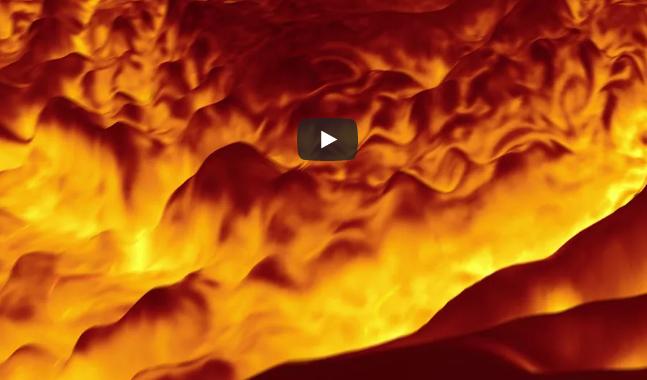
NASA’s Juno Mission provides infrared tour of Jupiter’s north pole
Washington, Apr 12 (IBNS): Scientists working on NASA’s Juno mission to Jupiter shared a 3-D infrared movie depicting densely packed cyclones and anticyclones that permeate the planet’s polar regions, and the first detailed view of a dynamo, or engine, powering the magnetic field for any planet beyond Earth. Those are among the items unveiled during the European Geosciences Union General Assembly in Vienna, Austria, on Wednesday, April 11.
Juno mission scientists have taken data collected by the spacecraft’s Jovian InfraRed Auroral Mapper (JIRAM) instrument and generated the 3-D fly-around of the Jovian world’s north pole. Imaging in the infrared part of the spectrum, JIRAM captures light emerging from deep inside Jupiter equally well, night or day. The instrument probes the weather layer down to 30 to 45 miles (50 to 70 kilometers) below Jupiter's cloud tops. The imagery will help the team understand the forces at work in the animation – a north pole dominated by a central cyclone surrounded by eight circumpolar cyclones with diameters ranging from 2,500 to 2,900 miles (4,000 to 4,600 kilometers), read the NASA website.
“Before Juno, we could only guess what Jupiter’s poles would look like,” said Alberto Adriani, Juno co-investigator from the Institute for Space Astrophysics and Planetology, Rome. “Now, with Juno flying over the poles at a close distance it permits the collection of infrared imagery on Jupiter’s polar weather patterns and its massive cyclones in unprecedented spatial resolution.”
Another Juno investigation discussed during the media briefing was the team’s latest pursuit of the interior composition of the gas giant. One of the biggest pieces in its discovery has been understanding how Jupiter’s deep interior rotates.
“Prior to Juno, we could not distinguish between extreme models of Jupiter’s interior rotation, which all fitted the data collected by Earth-based observations and other deep space missions,” said Tristan Guillot, a Juno co-investigator from the Université Côte d'Azur, Nice, France. “But Juno is different -- it orbits the planet from pole-to-pole and gets closer to Jupiter than any spacecraft ever before. Thanks to the amazing increase in accuracy brought by Juno’s gravity data, we have essentially solved the issue of how Jupiter’s interior rotates: The zones and belts that we see in the atmosphere rotating at different speeds extend to about 1,900 miles (3,000 kilometers).
“At this point, hydrogen becomes conductive enough to be dragged into near-uniform rotation by the planet’s powerful magnetic field.”
The same data used to analyze Jupiter’s rotation contain information on the planet’s interior structure and composition. Not knowing the interior rotation was severely limiting the ability to probe the deep interior. “Now our work can really begin in earnest -- determining the interior composition of the solar system’s largest planet,” said Guillot.
At the meeting, the mission’s deputy-principal investigator, Jack Connerney of the Space Research Corporation, Annapolis, Maryland, presented the first detailed view of the dynamo, or engine, powering the magnetic field of Jupiter.
Connerney and colleagues produced the new magnetic field model from measurements made during eight orbits of Jupiter. From those, they derived maps of the magnetic field at the surface and in the region below the surface where the dynamo is thought to originate. Because Jupiter is a gas giant, “surface” is defined as one Jupiter radius, which is about 44,400 miles (71,450 kilometers).
These maps provide an extraordinary advancement in current knowledge and will guide the science team in planning the spacecraft’s remaining observations.
“We’re finding that Jupiter’s magnetic field is unlike anything previously imagined,” said Connerney. “Juno’s investigations of the magnetic environment at Jupiter represent the beginning of a new era in the studies of planetary dynamos.”
The map Connerney’s team made of the dynamo source region revealed unexpected irregularities, regions of surprising magnetic field intensity, and that Jupiter’s magnetic field is more complex in the northern hemisphere than in the southern hemisphere. About halfway between the equator and the north pole lies an area where the magnetic field is intense and positive. It is flanked by areas that are less intense and negative. In the southern hemisphere, however, the magnetic field is consistently negative, becoming more and more intense from the equator to the pole.
The researchers are still figuring out why they would see these differences in a rotating planet that’s generally thought of as more-or-less fluid.
“Juno is only about one third the way through its planed mapping mission and already we are beginning to discover hints on how Jupiter’s dynamo works,” said Connerney. “The team is really anxious to see the data from our remaining orbits.”
Juno has logged nearly 122 million miles (200 million kilometers) to complete those 11 science passes since entering Jupiter's orbit on July 4, 2016. Juno's 12th science pass will be on May 24.
NASA's Jet Propulsion Laboratory, Pasadena, California, manages the Juno mission for the principal investigator, Scott Bolton, of the Southwest Research Institute in San Antonio. Juno is part of NASA's New Frontiers Program, which is managed at NASA's Marshall Space Flight Center in Huntsville, Alabama, for NASA's Science Mission Directorate. The Italian Space Agency (ASI), contributed two instruments, a Ka-band frequency translator (KaT) and the Jovian Infrared Auroral Mapper (JIRAM). Lockheed Martin Space, Denver, built the spacecraft.
Support Our Journalism
We cannot do without you.. your contribution supports unbiased journalism
IBNS is not driven by any ism- not wokeism, not racism, not skewed secularism, not hyper right-wing or left liberal ideals, nor by any hardline religious beliefs or hyper nationalism. We want to serve you good old objective news, as they are. We do not judge or preach. We let people decide for themselves. We only try to present factual and well-sourced news.







